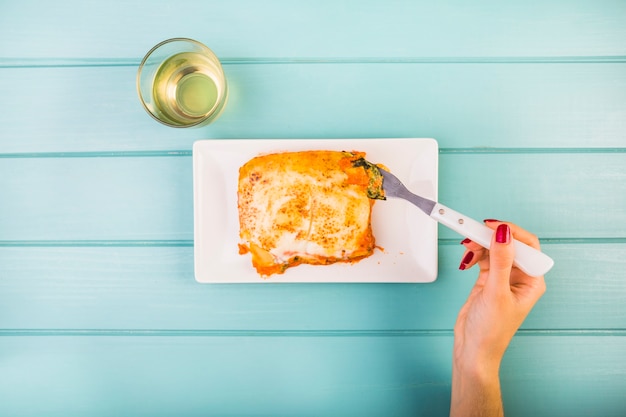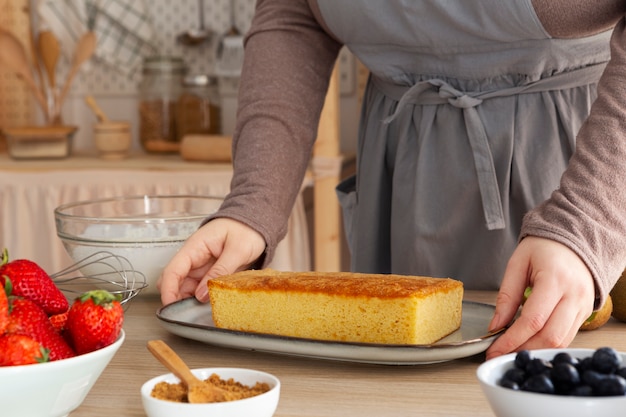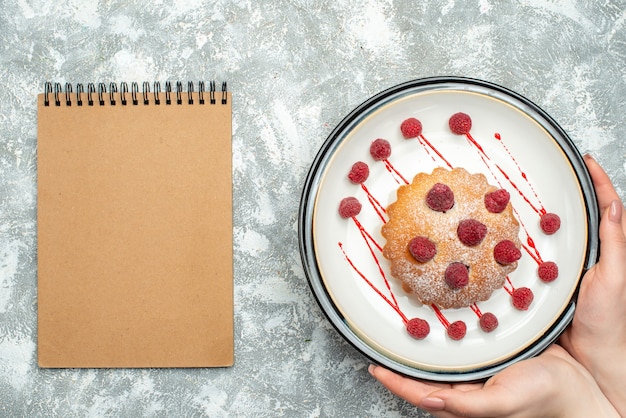Ah, flan. Just the name conjures images of that heavenly wobbly custard, coated in a glistening caramel shell. It's a dessert that's as beautiful as it is delicious, and frankly, a bit of a showstopper. But let me tell you, making a perfect flan isn't about some magical secret ingredient, it's about mastering a few simple techniques and understanding the key elements.
This guide is your roadmap to flan mastery. We'll delve into the intricacies of caramel, the secrets to a velvety smooth custard, and the crucial baking steps that make all the difference. And trust me, I'm not just throwing random advice your way. I've spent years perfecting my flan game, and I'm eager to share all my tips, tricks, and even a few embarrassing mishaps along the way. So, get your aprons ready, grab your favourite mixing bowl, and let's get started!
(Part 1) The Ingredients: The Foundation for Flavour

Choosing the Right Ingredients: The Heart of a Good Flan
Let's be real, you can't expect to conjure up a brilliant flan with subpar ingredients. Think of it like building a house: you wouldn't use flimsy materials, would you? You want a strong foundation to support that gorgeous custard.
Here's what I always reach for:
Milk: Whole milk is the king of flan. It brings that rich, creamy texture and a deeper flavour that just can't be beat.
Eggs: Go for large, fresh eggs. They give you a thicker, smoother custard that holds its shape beautifully.
Sugar: Granulated sugar is your go-to for both the caramel and the custard. You can get fancy with the caramel and experiment with brown sugar or even coconut sugar, but keep it simple with granulated for the custard.
Vanilla: A good quality vanilla extract is a must! Don't skimp here. A touch of vanilla really elevates the flavour, taking it from good to absolutely divine.
The Importance of Freshness
Freshness is paramount, especially with eggs. Stale eggs can lead to a less stable custard. You want those eggs to be plump and fresh, full of life, because they're going to be the backbone of your flan.
A Note on Dairy:
Don't worry if you're lactose-intolerant or prefer non-dairy options! Almond milk, coconut milk, or soy milk are all fantastic substitutes. Just remember, they might be a bit thinner than cow's milk, so you might need to adjust the amount you use to achieve the right consistency.
(Part 2) Mastering the Caramel: The Sweetest Touch

Making the Perfect Caramel: A Little Patience, a Lot of Reward
The caramel is the show-stopping element of a flan, and it can be a bit intimidating. But trust me, it's easier than you think. Just remember, you're dealing with hot sugar, so proceed with caution!
Here's my step-by-step approach:
1. The Pan: A medium-sized saucepan is your best friend. You want it to be just big enough to hold the sugar without spreading it out too much.
2. The Sugar: Use high-quality granulated sugar for a smooth, even caramel. Steer clear of brown sugar or other types, as they can burn quickly and create a bitter flavour.
3. Heat and Patience: Place the sugar in the pan and heat it over medium heat. Don't stir it! Just let it melt. You'll see it start to transform, melting and turning a beautiful amber colour.
4. The Art of Patience: This is where the magic happens. Be patient. Resist the urge to rush the process. Allow the sugar to melt slowly and turn golden brown.
5. The Swirl: Once the sugar is a rich, golden brown, swirl the pan gently to ensure the caramel is evenly coloured.
6. Water: The Taming of the Beast: This is a crucial step! Carefully add a tablespoon of water to the hot caramel. It'll bubble and sizzle, so be careful. The water helps to stop the caramel from burning further and gives it that smooth, glossy finish.
Tips for Caramel Success:
The Colour: The colour of your caramel is crucial. Aim for a beautiful golden brown, almost amber hue. Don't let it get too dark, as this will result in a bitter caramel.
The Bubbles: Watch for tiny bubbles forming on the surface of the caramel. It's a sign that it's getting close to being ready.
The Swirl: If you're unsure about the caramel, swirl the pan gently. If it flows smoothly and evenly, you're good to go.
(Part 3) The Custard: A Symphony of Flavour

Creating the Creamy Custard: The Heart of the Flan
Now, the custard. This is where your creativity can really shine. While the basic custard recipe is simple, you can add your own personal touch with different flavour additions and techniques.
Here's the classic custard recipe:
1. Whisk Together: In a large bowl, whisk together the eggs, sugar, and vanilla extract until they're light and frothy. This step incorporates air, making the custard lighter and more delicate.
2. The Milk: In a separate saucepan, gently heat the milk over medium heat until it's just simmering. Don't let it boil. You just want it to be warm enough to temper the eggs.
3. Tempering: This step is key to preventing the eggs from curdling. Slowly drizzle a bit of the hot milk into the egg mixture, whisking constantly. The warm milk gradually brings the temperature of the eggs up, preventing them from shocking when they're added to the hot milk.
4. Combine: Once the egg mixture is tempered, slowly pour it back into the saucepan with the rest of the warm milk.
5. Cook: Cook the custard over low heat, stirring constantly, until it thickens. The custard is ready when it coats the back of a spoon smoothly.
Custard Tips:
Don't Overcook: Overcooked custard will become rubbery and lose its luscious texture.
The Spoon Test: Dip a spoon into the custard and lift it out. If the custard coats the back of the spoon smoothly, it's ready.
Strain: If you want an extra-smooth custard, strain it through a fine-mesh sieve to remove any lumps.
(Part 4) The Baking Process: Patience is Key
Preparing the Flan for the Oven: A Few Crucial Steps
Now, for the baking. This part is easy, but it does require a bit of patience.
1. The Baking Dish: You'll need a baking dish large enough to hold the flan comfortably. A round, oven-proof dish is ideal, but a square dish works just fine too.
2. Caramel Lining: Pour the hot caramel into the baking dish and swirl it around to coat the bottom and sides evenly. Let it cool and solidify. This caramel layer will be the sweet, crunchy base of your flan.
3. The Custard: Carefully pour the custard over the cooled caramel.
4. water bath: The Secret Weapon: Here's the key to preventing your flan from cracking. Place the baking dish in a larger roasting pan. Pour enough hot water into the roasting pan to come halfway up the sides of the baking dish. The water bath creates a gentle, even heat that prevents the custard from cooking too quickly and cracking.
5. Baking: Bake the flan in a preheated oven at 325°F (160°C) for 45-60 minutes, or until the custard is set.
Water Bath: The Secret to a Smooth Flan
The water bath is an essential step. It's like giving your flan a warm hug, ensuring it cooks evenly and prevents those dreaded cracks.
(Part 5) Cooling and Serving: A Moment of Indulgence
Cooling the Flan: Patience Pays Off Again
After you take the flan out of the oven, let it cool completely in the water bath before serving. This allows the custard to set properly and prevent it from becoming too loose.
Serving Time: The Moment of Truth
Once the flan is completely cooled, you're ready to serve. It's best served chilled, and frankly, it tastes even better the day after it's made when the flavours have had a chance to meld.
Tips for Serving:
The Unmolding: To unmold the flan, run a thin-bladed knife around the edge of the dish to loosen it. Invert a plate over the top of the dish and carefully flip the flan onto the plate. The caramel should come with it, creating a beautiful, glossy coating.
The Garnish: Get creative with your garnish! Fresh fruit, whipped cream, chocolate shavings, or a sprinkle of chopped nuts all add a touch of elegance.
(Part 6) Flavour Variations: A World of Possibilities
Adding Your Own Twist: Flavour Adventures
The beauty of flan lies in its versatility. It's a blank canvas for your flavour creativity.
Here are a few ideas to spark your imagination:
Citrus: Add a tablespoon of lemon zest or orange zest to the custard for a bright, tangy twist. The citrus cuts through the richness of the custard and adds a refreshing touch.
Chocolate: A tablespoon of cocoa powder will transform your flan into a rich, decadent treat. Imagine that creamy custard with a hint of chocolate... heavenly!
Coffee: Brew a strong cup of coffee and add it to the custard for a rich, coffee-infused flan. Perfect for those who love a little caffeine kick with their dessert.
Nutty Delights: Add a handful of chopped nuts, like almonds, walnuts, or pecans, to the custard for a crunchy texture and a nutty flavour.
Table of Flavour Variations:
| Flavour | Ingredients | Tips |
|---|---|---|
| Lemon Flan | 1 tablespoon lemon zest | Add the lemon zest to the custard before you cook it. The flavour will infuse as it cooks. |
| Chocolate Flan | 1 tablespoon cocoa powder | Make sure to whisk the cocoa powder into the custard thoroughly to prevent lumps. A smoother texture is key! |
| Coffee Flan | 1/2 cup strong brewed coffee | Add the coffee to the custard after you've tempered the eggs. The heat of the custard will enhance the coffee flavour. |
| Nutty Flan | 1/2 cup chopped nuts (almonds, walnuts, pecans) | Add the chopped nuts to the custard just before you pour it into the baking dish. This keeps them crunchy and adds a delightful texture. |
(Part 7) Troubleshooting: Solving Common Flan Challenges
Facing the Challenges: Tips for Troubleshooting
Let's face it, even the most experienced bakers have their baking mishaps. But don't panic! With a little knowledge, you can overcome most common flan problems.
Here are some common flan challenges and how to avoid them:
Cracked Flan: This usually happens when the custard is overcooked. To avoid this, bake the flan in a water bath and don't overcook it. The water bath creates a more gentle heat, preventing the custard from cooking too quickly.
Watery Flan: This can happen if the custard isn't cooked long enough. Make sure to bake the flan until the custard is set, using the spoon test to check.
Burnt Caramel: Overcooked caramel is a common culprit. Keep a watchful eye on the caramel and make sure it doesn't get too dark.
Lumpy Custard: This can happen if the custard isn't whisked properly or if the eggs aren't tempered properly. Make sure to whisk the custard thoroughly and temper the eggs before adding them to the hot milk.
(Part 8) FAQs: Addressing Your Questions
Frequently Asked Questions: Your Flan Queries Answered
Here are some answers to your most common flan questions:
1. Can I use different types of sugar for the caramel?
You can experiment with different sugars for the caramel, like brown sugar or even coconut sugar. However, stick to regular sugar for the custard itself, as other types of sugar can affect the texture and flavour.
2. Can I make a flan ahead of time?
Absolutely! Flans actually taste even better the day after they're made, as the flavours have had a chance to meld. Just make sure to cool the flan completely before storing it in the fridge.
3. What if the flan doesn't unmold properly?
If your flan sticks to the baking dish, you can run a thin-bladed knife around the edge of the dish to loosen it. If it's still sticking, you can try placing the bottom of the dish in a bowl of hot water for a few seconds to loosen it.
4. What can I do if the custard is too thick?
If the custard is too thick, you can add a little more milk to thin it out. Just be sure to stir the milk in thoroughly to prevent lumps.
5. Can I freeze flan?
It's not recommended to freeze flan, as the texture can be affected. However, you can freeze the custard before baking it. Just thaw it overnight in the fridge before baking.
Your Flan Journey Begins Now!
There you have it: your ultimate guide to making the perfect flan. Remember, the most important thing is to have fun and experiment. Don't be afraid to try different flavours and techniques. The possibilities are endless. So go on, get baking, and impress your family and friends with your delicious creation.
Now, go forth and create a flan that's worthy of all the oohs and ahhs!
Everyone is watching

How to Cook Frozen Lobster Tails Perfectly: A Step-by-Step Guide
RecipesLobster. Just the word conjures up images of lavish meals, special occasions, and a taste of luxury. But let's...

Pigs in a Blanket Cooking Time: How Long to Bake for Perfect Results
RecipesAh, pigs in a blanket. Just the name conjures up images of those delightful little parcels of crispy pastry en...

Pork Fillet Cooking Time: How Long to Cook It Perfectly
RecipesPork fillet, or tenderloin as it's sometimes called, is a real favourite in our house. It's so versatile, and...

The Ultimate Guide to Cooking Delicious Frankfurters
RecipesLet's face it, we all love a good frankfurter. It's a classic, simple, and always satisfying. But let's be rea...

Wolf Meat Recipes: A Guide to Cooking Wild Game
RecipesLet's be honest, you don't see wolf meat at your local butcher shop every day. It's a bit of a wild card, but ...
